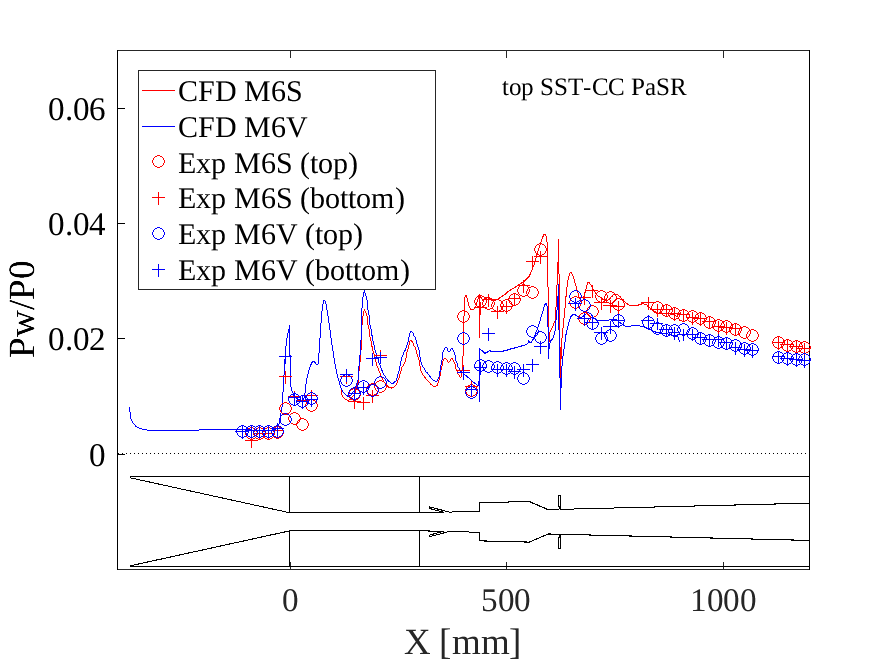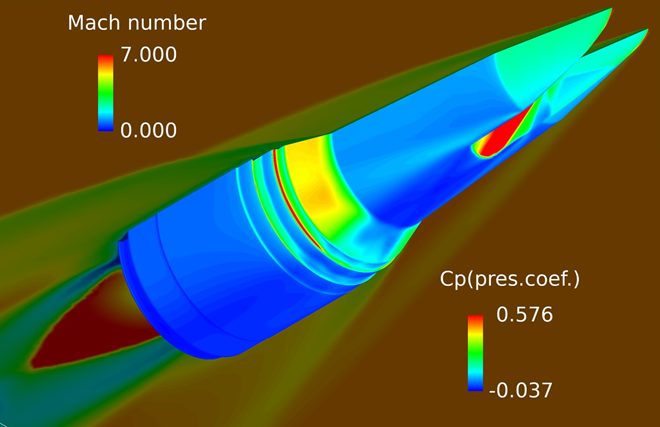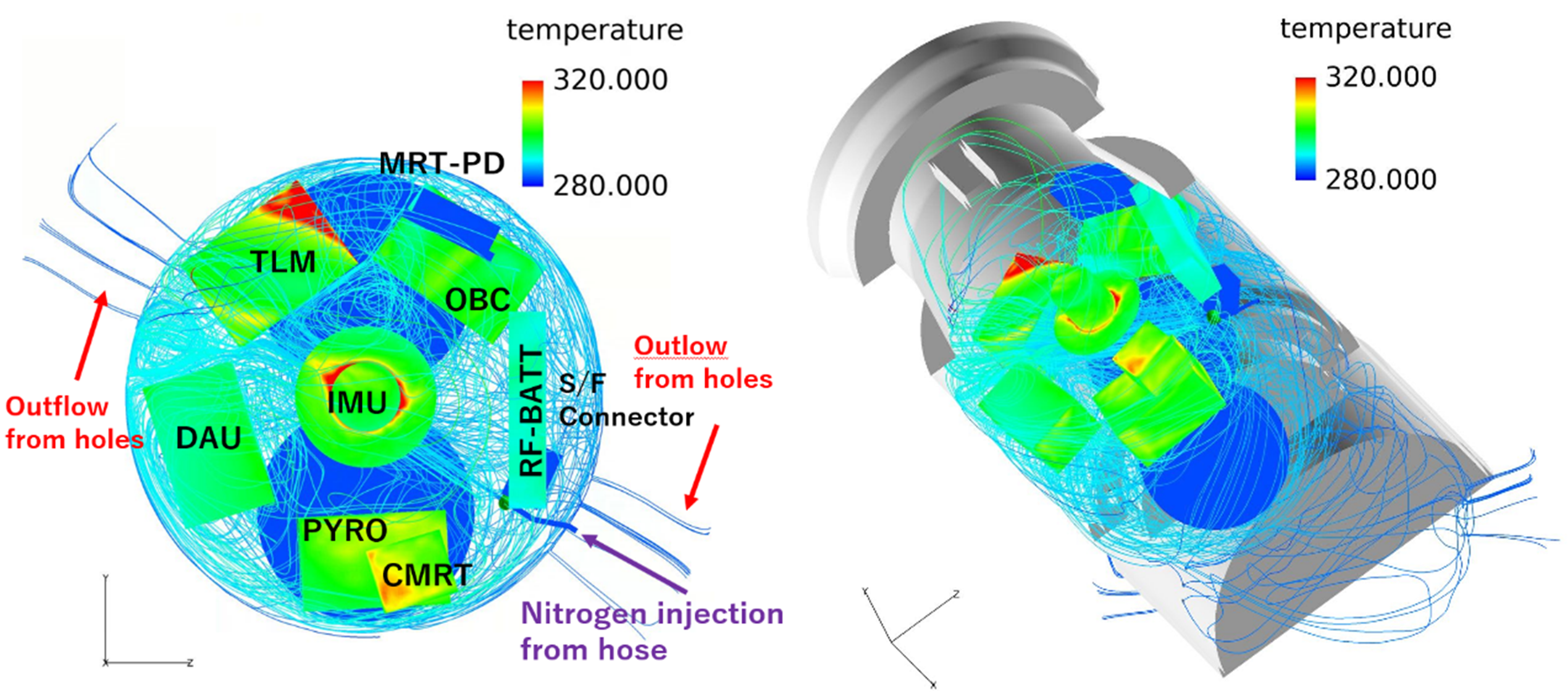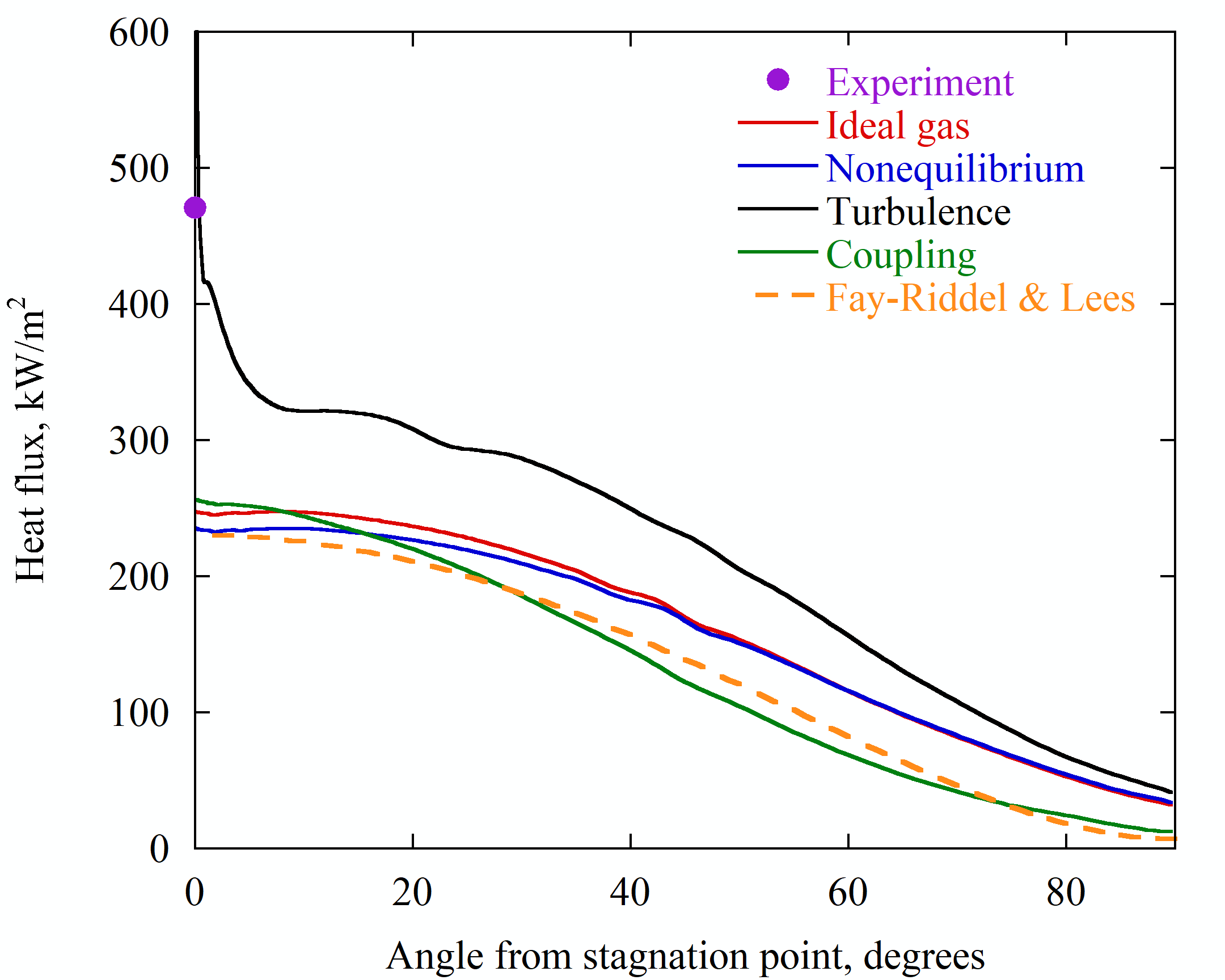Fundamental Researches of Fluid and Combustion for the Hypersonic Flight
JAXA Supercomputer System Annual Report February 2021-January 2022
Report Number: R21ECMP18
Subject Category: Competitive Funding
- Responsible Representative: Kouichi Okita, Director, Research Unit IV, Research and Development Directorate
- Contact Information: Masahiro Takahashi(takahashi.masahiro@jaxa.jp)
- Members: Masaaki Fukui, Susumu Hasegawa, Taku Inoue, Masatoshi Kodera, Toshihiko Munakata, Masaharu Takahashi, Sadatake Tomioka, Masahiro Takahashi, Gouji Yamada
Abstract
The wind tunnel tests by using sub-scaled models play important roles for the development of the air-breathing propulsion system for a hypersonic transporter. However, in some cases, the flow of the wind tunnel is ”vitiated” due to the heating process and/or the complex flow-path of the facility. To rise the total temperature to produce the high Mach number flow, a combustion heating is usually applied, introducing the water vaper to the air stream. The complex flow-path of the facility would increase turbulence. Both the phenomena might affect the supersonic combustion process. To clarify the effects of the flow vitiation and ultimately, to establish the adjustment methodology that can deduce the data of real flight from the wind tunnel data, JAXA has initiated the 5-years study. The final goal is conducting the flight experiment to obtain the data on the supersonic combustion in an actual flight condition and verify the methodology by using both the flight data and the corresponding wind tunnel data.
Reference URL
N/A
Reasons and benefits of using JAXA Supercomputer System
Recently, hydrocarbon fuels become more promising fuels for a supersonic combustor than hydrogen because of those high thrust density. A gaseous ethylene is selected as the fuel for the present flight experiment. Ethylene is rather simple hydrocarbon, but much more chemical species contributes to the combustion process than hydrogen. In addition, the flow conditions in the supersonic combustor and those around the hypersonic flight test vehicle are quire severe. As a result, the CFD for the present design evaluation requires large computation time. Furthermore, many cases of the CFD must be executed for aerodynamic design of the flight test vehicle and the combustor model within the scheduled period. Therefore, the use of the JSS system is essential for the success of the present research program.
Achievements of the Year
(1) Development of a tool for predicting facility dependence on supersonic combustion:
We are constructing a CFD tool that predicts the performance of an ethylene-fueled supersonic combustor for a flight test planned by JAXA. Supplemental ground tests by Ramjet Engine Test Facility (RJTF) were conducted for the combustor model before the flight test, and the tool is for predicting the difference between both the tests, especially capturing the effect of water vapor in the mainstream of RJTF. The CFD tool is based on a RANS method coupled with a reduced reaction mechanism and efficient Diagonal Algorithm to reduce the computational time. To modulate some parameters related to CFD, results obtained from the tool were compared to RJTF test results in terms of wall pressure distributions inside the combustor. Application of a partially stirred reactor (PaSR) model which takes into account turbulence-chemistry interaction to the tool seemed to be promising for reproducing the RJTF results (Fig. 1). In addition, CFD of a supersonic combustor flow for the JAXA RD1 flight experiment was conducted at three flow conditions, those represent the flow condition along the flight test trajectory. Fuel supply profile for the flight experiment was discussed using these results.
(2) Thermal and aerodynamic analysis of flight experiment model
Using CFD, which has been validated by comparison with the wind-tunnel test data, aerodynamic analysis of the flight experiment model for supersonic combustion was conducted with the flight Mach number range from 2 to 7, and the aerodynamic-characteristic database was constructed for the flight trajectory calculation. In addition, the aerodynamic heating to the flight experiment model was predicted by CFD, and the thermal analysis of the flight experiment model was conducted by using the CFD result to estimate the temperature rise of the model surface. The results showed that the surface temperature did not rise to the extent that there would be a risk of melting. Fig. 2 shows an example of CFD results, the distribution of the pressure coefficient on the surface of the flight experiment model and the Mach number distribution around the model.
(3) Thermo-fluid analysis to evaluate the effectiveness of the cooling for the instruments installed in the launch system for the flight experiment model.
Most electronic devices installed densely in the common instruments (CI) module of the launcher system for the flight experiment, such as an inertial sensor unit (IMU), are activated and start working before the launch. Therefore, the temperature inside the CI module rises due to the heat generated by the electronic devices, and there is a concern that the devices may malfunction or be damaged if the temperature would exceed the upper limit of the operation condition. To suppress the temperature-rise in the CI module before the launch, a nitrogen gas purge is applied. The nitrogen coolant gas is supplied from the outside into the CI section via a hose. Since the interior of the CI module is a complicated space, the heat transferred from the device surface to the nitrogen coolant gas was predicted by CFD, and using this, the time variation of the device surface temperature was estimated by a simple prediction tool, and the cooling effectiveness was evaluated. An example of the results of thermo-fluid analysis are shown in Fig.3, which shows the streamline of the nitrogen coolant gas (color indicates the gas temperature) and the surface temperature distribution of the onboard components. The figure on the left is a view from the nose of the launcher system, and the figure on the right is its bird’s-eye view.
(4) Development of a tool for predicting facility dependence on aerodynamic heating:
CFD analysis was performed using surface temperature distribution as a boundary condition. The calculated surface heat flux around a sphere at Mach 6.7 agreed well with the theoretical value predicted by an empirical formula, showing the validity of the calculated result. However, the calculated surface heat flux is lower than the experimental value. The calculated heat flux with turbulence showed a good agreement with the experimental value (Fig. 4).

Fig.1: Comparison between CFD results with PaSR model and experimental data by RJTF (wall pressure distributions on combustor top wall)

Fig.2: Computed pressure coefficient on the wall surface of the flight experiment model and Mach number distribution around the model.

Fig.3: The streamline traces of the coolant gas (color shows the gas temperature) and the surface temperature distribution on the onboard devices in the CI module, left: view from the nose of the launcher system, right: bird’s-eye view
Publications
– Peer-reviewed papers
1) Takahashi, Tomioka, Kodera, Kobayashi, Hasegawa, Shimizu, Aono, and Munakata, ”Numerical Study on Combustor Flow-Path Design for a Scramjet Flight Experiment,” Trans. JSASS Aerospace Tech. Japan, Vol. 19, No. 3, pp. 415-423, 2021, DOI: 10.2322/tastj.19.415
– Non peer-reviewed papers
1) Kodera, M., Takahashi, M., Kobayashi, K., and Tomioka, S., ”CFD Prediction of Scramjet Combustor Performance for Flight Experiment,” Proceedings of the 61st Conference on Aerospace Propulsion, JSASS-2022-0080, 2022.
2) Takahashi, Tomioka, Takegoashi, Kobayashi, Onodera, and Saito, ”Ground Test Evaluation of a Supersonic Combustor Model for JAXA Flight Experiment in Mach 6 Flight Condition,” Proceedings of the 33rd ISTS, ISTS-a-14, 2022.
– Invited Presentations
1) Tani, ”The Experiment for the Real Flight Data to Evaluate the Adjustment Tools of the Contamination Effect of Wind Tunnels,” Keynote Lecture 4, The 59th Symposium (Japanese) on Combustion. 2021.
– Oral Presentations
1) Kodera, M., Takahashi, M., Kobayashi, K., and Tomioka, S., ”CFD Prediction of Scramjet Combustor Performance for Flight Experiment,” The 61st Conference on Aerospace Propulsion, 2022.
2) Takahashi, Tomioka, Takegoashi, Kobayashi, Onodera, and Saito, ”Ground Test Evaluation of a Supersonic Combustor Model for JAXA Flight Experiment in Mach 6 Flight Condition,” The 33rd ISTS, 2022.
Usage of JSS
Computational Information
- Process Parallelization Methods: MPI
- Thread Parallelization Methods: OpenMPI + Automatic Parallelization
- Number of Processes: 1 – 960
- Elapsed Time per Case: 70 Hour(s)
JSS3 Resources Used
Fraction of Usage in Total Resources*1(%): 4.31
Details
Please refer to System Configuration of JSS3 for the system configuration and major specifications of JSS3.
| System Name | CPU Resources Used(Core x Hours) | Fraction of Usage*2(%) |
|---|---|---|
| TOKI-SORA | 101187946.33 | 4.92 |
| TOKI-ST | 255159.10 | 0.31 |
| TOKI-GP | 0.00 | 0.00 |
| TOKI-XM | 0.00 | 0.00 |
| TOKI-LM | 15188.29 | 1.13 |
| TOKI-TST | 158.27 | 0.00 |
| TOKI-TGP | 0.00 | 0.00 |
| TOKI-TLM | 0.00 | 0.00 |
| File System Name | Storage Assigned(GiB) | Fraction of Usage*2(%) |
|---|---|---|
| /home | 345.91 | 0.34 |
| /data and /data2 | 23094.24 | 0.25 |
| /ssd | 702.95 | 0.18 |
| Archiver Name | Storage Used(TiB) | Fraction of Usage*2(%) |
|---|---|---|
| J-SPACE | 8.34 | 0.06 |
*1: Fraction of Usage in Total Resources: Weighted average of three resource types (Computing, File System, and Archiver).
*2: Fraction of Usage:Percentage of usage relative to each resource used in one year.
ISV Software Licenses Used
| ISV Software Licenses Used(Hours) | Fraction of Usage*2(%) | |
|---|---|---|
| ISV Software Licenses(Total) | 3909.74 | 2.74 |
*2: Fraction of Usage:Percentage of usage relative to each resource used in one year.
JAXA Supercomputer System Annual Report February 2021-January 2022



